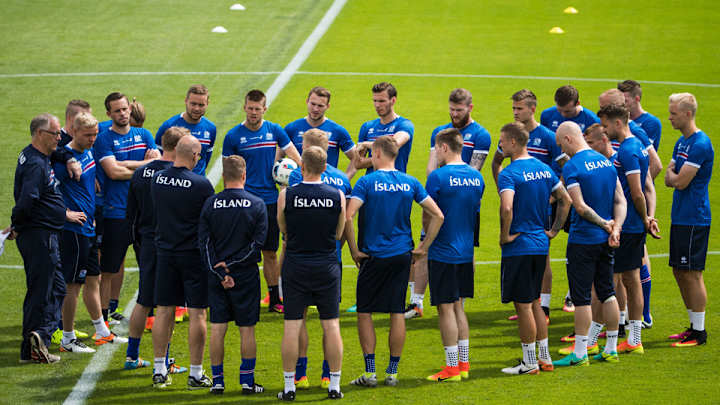Can Iceland turn its qualifying magic into Euro 2016 results?

After defeat in a World Cup qualifying playoff to Croatia in 2013, there were fears that Iceland had missed its chance.
This is, after all, a country of just 323,000 population without a great football tradition. Chances to qualify for major tournaments don’t come along often. Lars Lagerback and Heimir Hallgrimsson’s side, though, began Euro 2016 qualifying with a 3-0 victory over Turkey and barely looked back, also beating the Netherlands and the Czech Republic at home on its way to becoming one of the first teams to qualify for a place in France. The question now is whether qualification represents the limits of its potential.
Simply getting here is a remarkable achievement. This is a country so small that Hallgrimsson still works as a dentist in his home town of Vestmannaeyjar, while goalkeeper Hannes Thor Halldorsson, who plays for the Norwegian side Bodo/Glimt, is a film director who produced Iceland’s Eurovision entry in 2012. They are professionals, but there is something of the amateur ethos about the way they continue to pursue other careers–although Hallgrimsson will surely cut back on the dentistry when he becomes full-time national coach when the 67-year-old Lagerback retires after the tournament.
Iceland's place at Euro 2016 a result of calculated development, growth
Much has been made of Iceland’s rise since 2007-08 when it lost successive games to Latvia, Liechtenstein, Denmark, Belarus and Malta. Much of the credit goes to Siggi Eyjolfsson, who is head of education at the Icelandic Football Association (KSI) and who has transformed coaching in the country. When he took the role in 2003, Iceland’s coaching qualifications were not recognized by UEFA.
Now it has more UEFA-licensed coaches per capita than anywhere else in Europe. Investment in indoor pitches, much of it stemming from the years of boom before the economic crash of 2007, means that football is now a year-round pursuit, rather than being confined to the summer months when the weather permits games to be played outside.
There are now seven "football houses" with full-size indoor pitches as well as more than 300 artificial pitches in Iceland.
“The changes are immense,” former Portsmouth defender Hermann Hreidarsson said in an interview with The Observer. “I was 23 when I signed for Crystal Palace in 1997 but, in terms of technical ability, I was about as good as a 14-year-old nowadays. The youth coaches deserve so much credit.”
Still, there remains something freakish about this success, the fluke of a fine generation all emerging at around the same time.
Euro 2016 Power Rankings: Host France the favorite in open field
The best known of them remains a player from a slightly older generation, 37-year-old former Chelsea and Barcelona forward Eidur Gudjohnsen. He retired from the national side after the playoff defeat to Croatia and his participation was in doubt after a brief stint with the Chinese club Shijiazhuang came to an end in November, but he joined Norwegian side Molde in February and has regained fitness there. The likelihood, though, is still that he will be used largely from the bench.
He admits he probably wouldn’t be playing now if it weren’t for the Euros.
“I thought, 'These boys might be going to the Euros and I might miss out,' but then I just put my mind to it," Gudjohnsen said. "‘Right, let's do this. let's see how far you can get, see how fit you can be, see how well you can play still.’”
- EURO 2016: Full standings, statistics, live gamecasts
Throughout qualifying the shape remains the 4-4-2 Lagerback has used for most of his career, although this is probably a more proactive, attacking version of the system than the one he employed in his years as national coach of his native Sweden. Most of the creativity comes from Gylfi Sigurdsson of Swansea City, whose dead-ball prowess is a major weapon.
There is a question over who will take the striking roles, though. Kolbeinn Sigthorsson of Nantes and Jon Dadi Bodvarsson of Kaiserslautern were the first-choice pairing for much of the qualifying campaign, but after joining Augsburg in January, Alfred Finnbogason has been in fine form, scoring seven times as the Bundesliga club avoided relegation.
There is also a concern about how form has dipped in the months since qualification was secured at the beginning of September. Since winning 1-0 in the Netherlands, Iceland has won just three of its last 12 games (3-7-2). It may be that that’s a natural reaction to the extraordinary achievement of qualification, and it may be that the adrenaline will kick in once again once the tournament starts for real, but it’s also a possibility that a country with the meager resources of Iceland can only ride a wave for so long.
In a sense it doesn’t matter. Getting to a tournament is already the greatest achievement in Iceland’s football history. The draw, though, has been relatively kind with the game against Hungary providing an obvious opportunity for a victory that could see Iceland through as the best-third place team. But then a side that has beaten the Netherlands, Turkey and the Czech Republic over the past two years has no reason to fear Portugal or Austria either.

An accomplished author of multiple books, Jonathan Wilson is one of the world’s preeminent minds on soccer tactics and history.